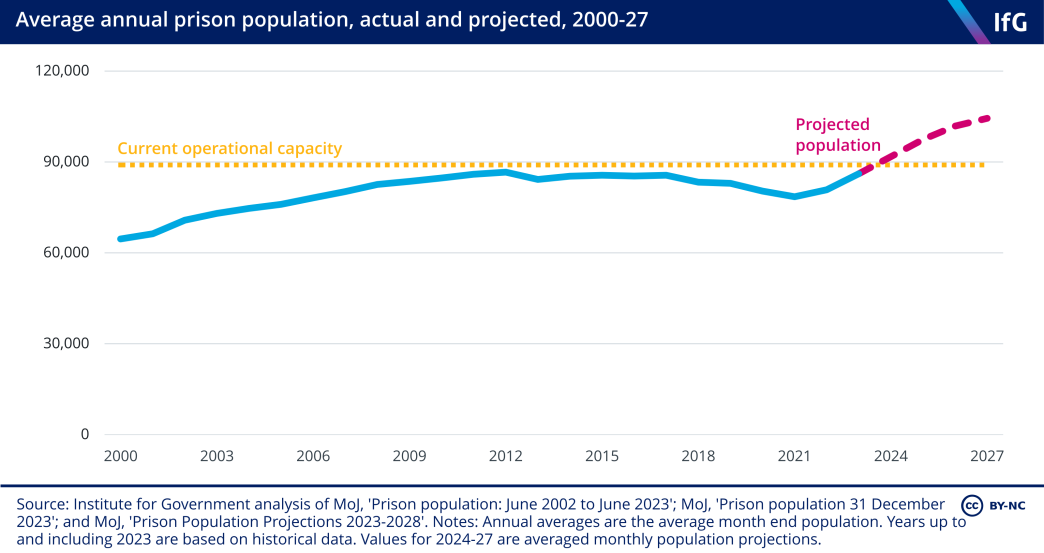The government's Sentencing Bill won’t fix its prison problems
Increasing sentences is empty rhetoric given our packed prisons.

Cassia Rowland argues that the new Sentencing Bill will not resolve capacity problems – so the government’s claims of tougher sentences are not credible
This March, prisons in England and Wales were stretched to their limits, with only a few hundred prison spaces available in the male prison estate. 31 www.telegraph.co.uk/news/2024/03/11/early-release-prisoners-jail-alex-chalk/ The government’s emergency measures have seen prisoners released up to 60 days early and sentencing hearings delayed, easing the most immediate threat, but these are not long-term solutions.
The Sentencing Bill, currently waiting to go to committee in the House of Commons, is partly intended to address this capacity crisis. It includes two key measures: introducing a presumption to suspend sentences of less than 12 months, and expanding the Home Detention Curfew Scheme. These will help mitigate the capacity crunch, but they will not be sufficient.
The bill’s measures to bring down numbers will have a limited impact
The bill introduces a duty to suspend all sentences of less than 12 months, except in exceptional circumstances or where there is significant risk of harm to an individual, meaning offenders will serve their sentence – supervised by the probation service - in the community. This should help immediately manage demand on prisons, though it may create problems for probation capacity. But the actual impact on the prison population will be limited. Those on short sentences make up a small proportion of the total prison population: just 5% in 2022. 32 UK Parliament POST, POSTbrief 52, ‘The use of short prison sentences in England and Wales’, 2023, researchbriefings.files.parliament.uk/documents/POST-PB-0052/POST-PB-0052.pdf The government estimates this measure will reduce the prison population by between 200 and 1,000 a year, depending on how sentencers respond. 33 MoJ, Sentencing Bill Impact Assessment – Short Sentences, 2023, www.gov.uk/government/publications/sentencing-bill-2023
Expanding the Home Detention Curfew (HDC) scheme will also have a limited impact. HDC allows certain offenders to be released from custody six months before their automatic release date, under conditions and with a curfew enforced by an electronic monitor. Currently, the scheme is only available to those with sentences between twelve weeks and four years; the new bill expands it to include those serving longer sentences, although exclusions still apply to certain offences such as homicide or sexual offences. It also removes a lifetime ban on participating in the scheme for those who have previously breached an HDC, replacing it with a two-year ban.
Like the short sentence reform, this measure will reduce strain on prisons but not dramatically. The government estimates it will cut the prison population by around 850 people a year, with an equivalent rise in the probation and electronic monitoring caseload. Taken together, these changes are unlikely to be enough to address the current crisis.
The bill fails to grapple with the scale of the problem
The capacity crisis in prisons is not a new problem, and it is one the government has seen coming. Progressively longer sentences (the average custodial sentence has gone from 12.7 months in the year ending June 2003 to 20.4 in June 2023 34 Criminal justice statistics: July 2012 to June 2013, sentencing tables June 2013, table 5.5, www.gov.uk/government/statistics/criminal-justice-statistics-quarterly-june-2013 ) mean demand has been growing for years. Rising police recorded crime and charges will mean this number continues grow. Current projections – which do not incorporate the changes proposed in the new bill – show the prison population rising to 96,200 in a year’s time. By March 2028, it is estimated to reach 105,800. 35 Ministry of Justice, Prison Population Projections 2023 to 2028, England and Wales, pdf Our current useable prison capacity? Less than 89,000. 36 Ministry of Justice, Prison population figures: 2024, Population bulletin: weekly 22 March 2024, www.gov.uk/government/publications/prison-population-figures-2024

Nor can the government build its way out of this crisis. Even apart from the lead time needed to build new prisons, successive governments have faced major challenges in expanding capacity. Despite plans to have 20,000 additional spaces by the mid-2020s, that has now been pushed to 2030, with only 8,200 new places expected by May 2025. 37 https://www.theguardian.com/society/2023/sep/29/plan-for-20000-more-prison-places-in-england-and-wales-wont-be-complete-until-2030#:~:text=5%20months…. The poor quality of prison infrastructure means existing spaces may be lost even as new ones are built, as recently demonstrated by the closure of 184 places in HMP Dartmoor after concerns about radon gas. 38 questions-statements.parliament.uk/written-questions/detail/2024-02-29/16370/
Measures to increase time served for serious offences cannot currently be implemented – as the government itself acknowledges
If parts of the bill will only have a minimal impact on reducing prison numbers, two other measures would actually increase the prison population. The most significant affects sentences for rape and other serious sexual offences. Currently, these offenders are automatically released after serving two-thirds of their sentence in custody, and serve the remaining time on licence in the community. Under the new law, they would serve their entire sentence in custody, and then have an additional period of supervision after release.
The use of whole life orders – lifelong imprisonment, reserved for the most serious offenders – will also be expanded. In cases where a whole life order is the sentencing starting point, there will be a presumption that it will be applied. This group will now include those convicted of at least one murder with a sexual or sadistic element, though this is only expected to apply to around five cases per year. 39 MoJ, Sentencing Bill Impact Assessment – Whole Life Orders, 2023, www.gov.uk/government/publications/sentencing-bill-2023
The government estimates these changes will require 1,500 additional prison spaces by March 2034, and 2,850 by 2047/48. 40 MoJ, Sentencing Bill Impact Assessment – Sexual Offences, 2023, www.gov.uk/government/publications/sentencing-bill-2023 However, the provisions on rape and serious sexual assault sentences will only come into effect when there is sufficient prison capacity. This is unlikely to be anytime soon.
The changes would only apply to those sentenced after the bill is passed, so would take some time to filter through to the prison population. Nonetheless, current plans to expand prison capacity will not even keep pace with current demand projections and further expansions to the prison estate are highly unlikely. As such, the measures set out in the bill should be seen as an act of political posturing by the government, driven by a desire to present itself as ‘tough on crime’.
Ultimately, the government is misleading the public by suggesting it is increasing sentences for serious offenders – the prison capacity to implement these changes simply does not exist. Suspending short sentences and expanding home detention will help bring numbers down, but this bill is bailing out a sinking ship with a paper cup. Increasing time in custody for serious offenders would only knock new holes in the hull.
- Topic
- Public services
- Keywords
- Prisons Criminal justice Police Public spending
- Department
- Ministry of Justice
- Publisher
- Institute for Government